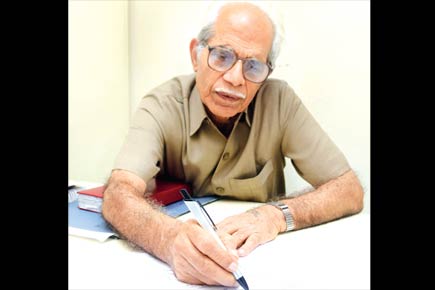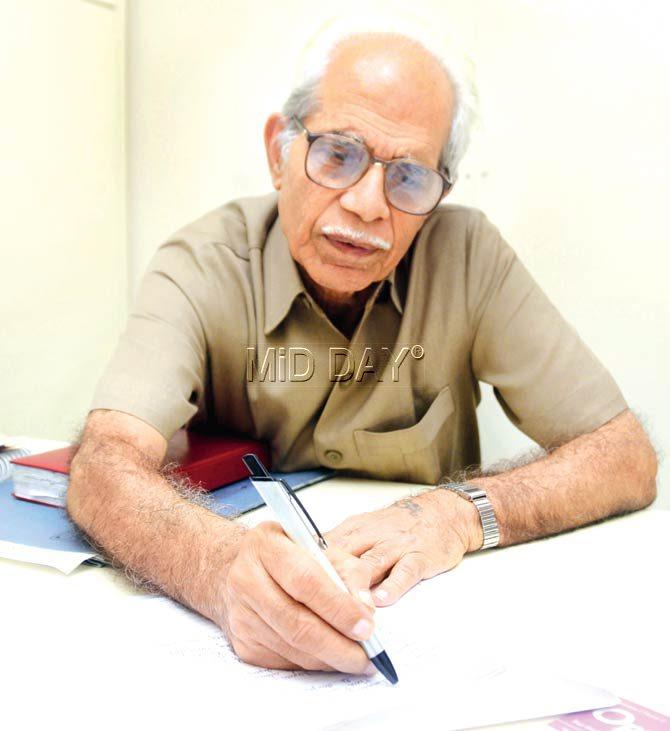It's been a while since we took our handwriting seriously. Apart from a quick shopping list scribble, writing a couple of lines on a birthday card or completing a form at the bank, there's little else we get to practise our handwriting on

Shyam Motwani

Initially, we were asked to write as fast as we could. Pic/Sneha Kharabe
ADVERTISEMENT
It's been a while since we took our handwriting seriously. Apart from a quick shopping list scribble, writing a couple of lines on a birthday card or completing a form at the bank, there's little else we get to practise our handwriting on. So, when this writer came across a pamphlet by Shyam Motwani, founder of Radio Bhuvan, the Career Supermarket (RBCS), claiming he could 'guarantee' elegant penmanship in just 15 minutes, the prospect seemed intriguing.
At the RBCS Centre, housed on the second floor of an antiquated building at Apollo Bunder at 6 pm, Motwani dressed in a steel grey safari suit, welcomes us to his study with its pale yellow walls and sturdy teakwood chairs.
"I might be 82, but I've never had a problem bonding with you youngsters, because you see, it's all in the mind," he says. The octogenarian has been taking handwriting workshops for the last 40 years. "I learnt ways to devise better handwriting entirely through trial and error and mind training. I am also trained in graphology," he tells us.

Shyam Motwani
We are then handed a sheet of paper that reads, "Handwriting reflects your personality. So, this is your first bold step in changing for the better." The sheet has a list of five questions that we are expected to handwrite, "as it is" and as fast as we can. The questions are generic ranging from educational background to how often we write by hand. We write with speed to complete it in the stipulated time.
Before
Analysing our handwriting, he says, "'Your handwriting is certainly not bad. There needs to be a slight slope to the letters, and you have a straight vertical form, which means you keep your emotions in check. You're very practical."
He points to places where our Ks and Os are larger than the rest. "For a neat, legible script, the size of the letters needs to be uniform." He instructs us to write each letter on a single line ensuring the letters are uniform. The baseline alignment, he notices, is off with a certain words. "Although you do write on the line, one or two letters have slipped slightly. I want you to consciously make an effort to stay on the line." His analysis: that this writer is well-adjusted, adaptable and liked by people, but tends to overthink at times.
"Always remember the four aspects. Slope, size, space and alignment," he states. Next, we are asked to write a paragraph 3-4 times, till we begin to get conscious of how we write. "If it's a scrawled mess, start by slowing down. Your handwriting is a reflection of your mind. Change your handwriting, and notice the difference in your attitude," he says.
After
We answer the same questions again on a blank sheet of paper. This time, however, we are more conscious of our letters and writing. As we write, the difference is visible and the letters have more clarity.
The expert says, "You don't need me to tell you that there's a difference. Earlier, your writing had an underlying sense of stress. You were writing under pressure. There's more neatness, clarity and uniformity in your writing now," he says.
But, the difference, he says, is because our mind right now is less cluttered and not invaded by distractions. However, Motwani adds, good handwriting involves a lot of work. "Start training your mind to write in a certain way, and you'll do it even when you write fast."
Verdict
As we leave, we ponder over how much truth lies in graphology. Do we really believe that by reducing the size of a 'K' or getting in my 'O' in line with the rest can make us less stressed in life. But, what we certainly do believe is that neat, legible writing gives one a feeling of a task well done.
 Subscribe today by clicking the link and stay updated with the latest news!" Click here!
Subscribe today by clicking the link and stay updated with the latest news!" Click here!






